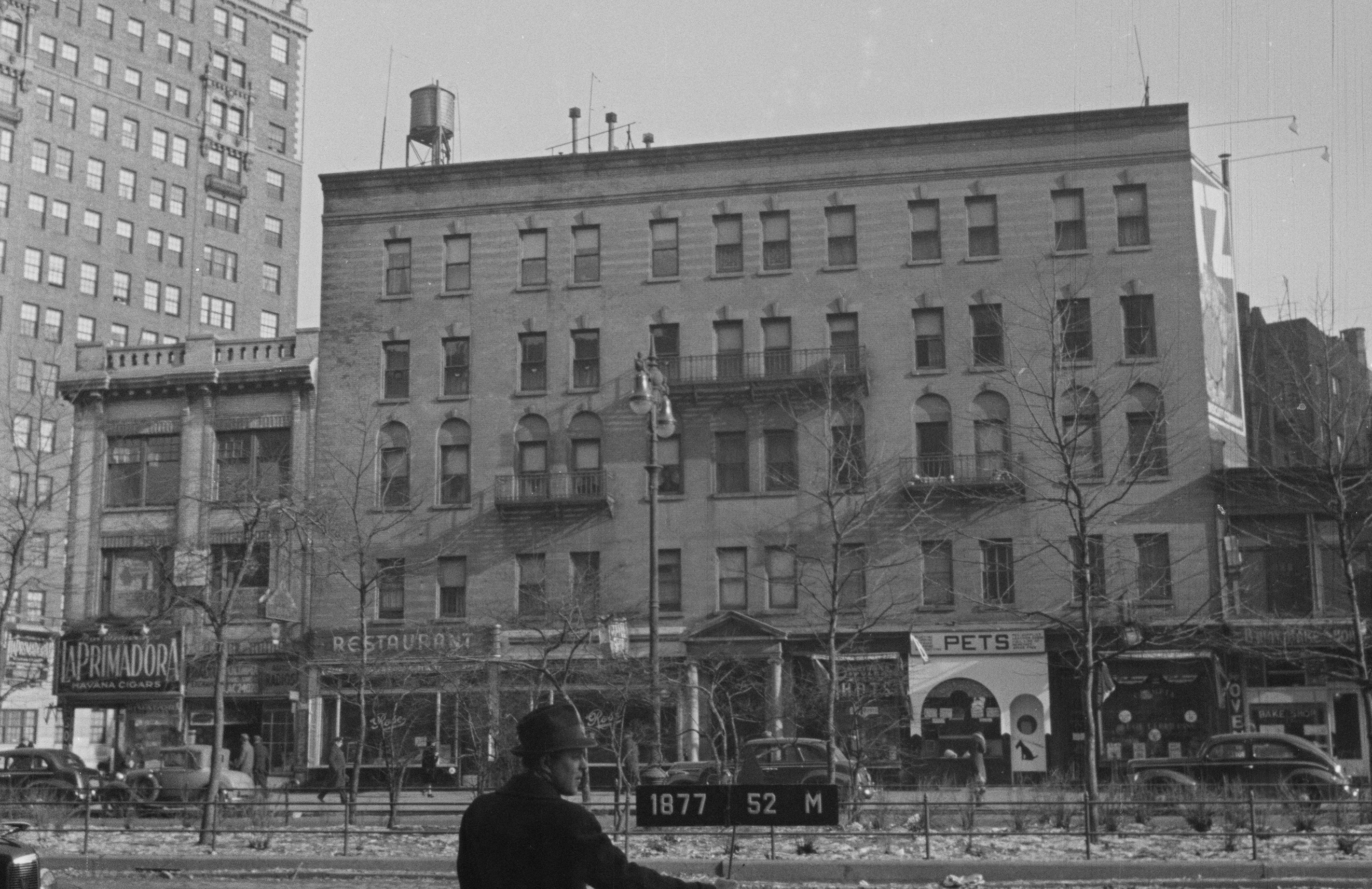
The Kenmac
by Tom Miller
Alexis Reed McIlvaine and Allen Tucker may have met while studying at Columbia University’s School of Architecture. Or they possibly became acquainted while both worked in the office of architect Richard Morris Hunt. In either case, by the mid 1890’s they had formed the firm of McIlvaine & Tucker. The partnership would be relatively short-lived because Tucker’s true passion was not architecture, but painting. In 1904 he gave up architecture to focus entirely on art.
But before dissolving their firm, the partners designed many buildings in Manhattan and elsewhere, including the five-story flat-and-store structure on the east side of Broadway, between 105th and 106th Streets. Faced in red brick and trimmed in white stone, the architects gave the Kenmac Colonial Revival details—like the blind timpani over the third-floor windows, and the splayed lintels and layered keystones of the fourth. An impressive limestone portico with Ionic columns and an intricately carved pediment served the residential entrance at the center of the property. Stores occupied the ground floor.
Among the first commercial tenants was the newly organized real estate office of Preuss & Gless at 2750 Broadway. In reporting the opening of their “handsome office” on May 6, 1899, the Record & Guide noted, “Their office is in a district which is now the scene of much activity in the way of building and selling.” Moving into 2758 Broadway was the Bellebrook Sanitarium, which despite its misleading name, sold plumbing fixtures like the Water Lily Bath and the Enema and Douche Attachment. Less eyebrow-raising was Pompadour’s dyeing and cleaning establishment, located at 2754 Broadway.
The residents were financially comfortable, middle- to upper-middle-class professionals. Among the initial residents was Major Robert Phillips Noah. As a young man, he was storekeeper at the United States Consulate in Rio de Janeiro. When word of the Confederate attack on Fort Sumter arrived, the Consul, a Southerner by birth, pulled down the American flag. The Evening Post later reported that when he did so, “Major Noah turned him out, took possession of the consulate, and restored the flag.” Noah would serve in two more wars: the Spanish-American, and the Crimean, earning his rank during the latter. Also living here at the turn of the century were Elia S. Yovtcheff, a county detective; architect Frank M. Snyder; and A. J. Becker, president of the City Island Railroad Company.
A customer buying three pounds of coffee, for instance, for $1.00 received four pounds of sugar free.
Paul Milkowitz took over the former Pompadour dry cleaning space by 1904. His interior decorator and painting firm promised “up-to-date paper hanging.” Another real estate firm, Stockdale & Julian was operating from 2752 Broadway that year. In 1915 they would be supplanted by The House of Free Sugar, a tea and coffee store. Its gimmick, as the name suggests, was to give free sugar with the purchase of “tea, coffee, cocoa, rice and canned goods.” A customer buying three pounds of coffee, for instance, for $1.00 received four pounds of sugar free. Additionally, an advertisement touted, “Purchases of $2.00 or over delivered free in N.Y., or within 500 miles on orders of 10 dollars or over.”
Living in a third-floor apartment in 1912 was the Ledger family. That summer they had a houseguest, 40-year-old Alice Sanborn, who lived in Brooklyn. On the night of August 6, Alice struck a match to light an alcohol lamp. Newspapers differed on the details of what followed. The New York Press said, “the head of the match fell on the bed, setting the cover afire. Miss Sanborn attempted to beat out the flames, but a kimono which she had slipped on caught fire.” The New York Call’s version was slightly different. It said that the lamp “exploded.” Both newspapers agreed that she was horribly burned and when she was removed to the J. Hood Wright Hospital, she had lost consciousness. Alice Sanborn died there two days later.
Several residents of the Kenmac were affluent enough to spend the warm months at fashionable resorts. Among them was the George Kramer family, who lived here in 1917. That summer they stayed at the Lafayette Hotel in Asbury Park. An annual carnival took place there in August, but this year was special. The United States had entered World War I in April, so in conjunction with the carnival, August 29 was declared New Jersey Patriotic Day. Among the festivities was a pageant, The Triumph of Democracy, held in the Asbury Park Arcade. The Brooklyn Daily Eagle reported that during the show, “Queen Titania will abdicate the throne, giving way to Miss Liberty.” The Kramers’ daughter, Olivia, had been picked for a role. She would “attend first Queen Titania and afterward Miss Liberty,” said the article.
In 1919 the Olympia Cigar Store occupied 2758 Broadway. On May 1 that year, Tobacco magazine praised its “large and pleasing window display of Epoca, Generals, ‘the Cigar of a Gentleman.’” The following year in December, Earnest Loeb, who had formerly been employed as a jeweler with Wanamaker’s, opened his watch and jewelry store at 2752 Broadway.
Less than a year after its opening, Earnest Loeb’s store was the scene of a terrifying robbery. At around noon on November 16, 1921, three gunmen entered. They forced the manager, Joseph Harvath, and the clerk, Max Phillips, into a back room at gunpoint. The New York Herald reported, “One robber kept them covered, while the second rifled the show cases [sic] and the third acted as a lookout.” The thieves made off with more than $1,000 in jewelry (more than $15,000 today). Although the police were notified as soon as the trio fled, no trace of them was found.
More changes to the commercial tenant list came in the 1920s. The newly formed E. Blout, Inc. signed a lease in October 1923 for 2756 Broadway. The store sold “talking machines.” Next door at 2754 Broadway was the John D. McDermott funeral parlor. It was the scene of a heart-wrenching funeral that year. “Pretty Dorothy Keenan,” as described by The Morning Telegraph, had been found murdered in her West 57th Street apartment on March 15. The unsolved murder of the wealthy woman drew much press attention. On March 19 The Morning Telegraph said at the Keenan home “no news about the funeral could be obtained,” however “at the funeral parlors of John D. McDermott, 2754 Broadway, it was admitted that the funeral had taken place and that the body was on the way to the cemetery.” The subterfuge was to “outwit the curious, including reporters, women writers and photographers.”
“The Federal agents used sub-machine guns, high powered rifles and revolvers. Their shots riddled the apartment.”
Living here in 1936 was the LeBeau family, including daughters Madeline and Arlene. Federal agents received a tip that in November Arlene had married bank robber Harry Brunette. He was also wanted for kidnapping State Trooper William A. Turnbull. Turnbull had stopped Harry for speeding. Arlene was in the passenger seat. Brunette overcame the trooper, transported him over state lines to Pennsylvania, and left him gagged and bound in a ditch.
On December 15, 1936, The Brooklyn Eagle reported, “The members of the LeBeau family were watched night and day.” On the previous day, Arlene and Madeline left the Kenmac apartments and went shopping. They were trailed by undercover agents. At 105th Street they separated, Madeline going home and Arlene to an apartment on 102nd Street. That building was surrounded by FBI agents. What happened next was right out of the 1930s gangster movie. The Brooklyn Eagle ran the headline, “G-Men Blast Kidnapper and Red-Headed Girl From Hideout Flat with Gas Bombs, Guns.” The New York Post reported, “The Federal agents used sub-machine guns, high powered rifles and revolvers. Their shots riddled the apartment.” Tear gas bombs were thrown through the windows. Arlene LeBeau Brunette, who had been shot in the leg, “dashed into the hall, eyes streaming, her wound bleeding profusely.” Arlene was charged with having been an accomplice in three bank robberies and was remanded to the Clinton, New Jersey Reformatory Hospital.
The second half of the 20th century saw changes in the Broadway neighborhood. By 1988 Lucy’s Surfeteria operated at 2756 Broadway, followed by Bluestar Restaurant in 1990. That eatery was supplanted by the Italian restaurant Meridiana in 1994. The West End Hall Tavern occupied the space from 2017 through 2019, when Calle Ocho opened. The stretch of commercial spaces saw several restaurants over the years. In 2015 Macchina was in 2758 Broadway, and in 2018 Mama’s Too pizza restaurant was operating from 2750 Broadway.
McIlvaine & Tucker’s Kenmac apartment house is little changed after nearly 125 years. Most astounding is that the two-step stoop and entrance portico have survived intact.
Tom Miller is a social historian and blogger at daytoninmanhattan.blogspot.com
BUILDING DATABASE
Keep Exploring
Be a part of history!
Think Local First to support the businesses currently at 2750-2758 Broadway:



